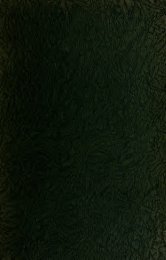Memoirs on the coleoptera
Memoirs on the coleoptera
Memoirs on the coleoptera
You also want an ePaper? Increase the reach of your titles
YUMPU automatically turns print PDFs into web optimized ePapers that Google loves.
CERAMBYCID.E 239<br />
A Similar but still more el<strong>on</strong>gate, with narrower and less transverse<br />
prothorax, less approximate eyes and still smaller head, <strong>the</strong> scutellum<br />
larger, broader and more rounded; eyes separated by two-<br />
thirds <strong>the</strong>ir own width; elytra fully twice as l<strong>on</strong>g<br />
as wide; tarsi<br />
similar. Length ( 9 ) 41.0 mm.; width i6.omm.; length and width<br />
of <strong>the</strong> prothorax 6.0X12.3 mm. Locality unrecorded.<br />
prolixus n. subsp.<br />
Form much stouter, larger, black, <strong>the</strong> elytra ra<strong>the</strong>r abruptly dull rufous<br />
in apical two-thirds; head more developed, two-thirds as wide as<br />
<strong>the</strong><br />
<strong>the</strong><br />
prothorax, <strong>the</strong> eyes separated by three-fourths <strong>the</strong>ir width,<br />
mandibles notably larger and thicker; antennae much shorter,<br />
scarcely extending to basal third of <strong>the</strong> elytra, <strong>the</strong> last joint as l<strong>on</strong>g<br />
as <strong>the</strong> preceding but narrower; prothorax relatively much narrower<br />
and less transverse though similar o<strong>the</strong>rwise, <strong>the</strong> scutellum similar;<br />
elytra much broader, with <strong>the</strong> arcuate sides more narrowly rounding<br />
behind, nearly two-fifths wider than <strong>the</strong> prothorax, two-thirds<br />
l<strong>on</strong>ger than wide; tarsi and metasternum similar; body beneath<br />
black, <strong>the</strong> abdomen red. Length (9 ) 47-O mm.; width iS.o mm.;<br />
length and width of prothorax 6.7X12.5 mm. Indiana.<br />
bicolor n. sp.<br />
13 Species of <strong>the</strong> Atlantic regi<strong>on</strong>s. Body rulo-piceous in color, shining,<br />
<strong>the</strong> prothorax sparsely punctulate, transverse though less so than<br />
in pocularis, scarcely more than twice as wide as l<strong>on</strong>g, str<strong>on</strong>gly<br />
bisinuate at base, <strong>the</strong> lateral teeth ra<strong>the</strong>r prominent, <strong>the</strong> posterior<br />
angles right; elytra wider than <strong>the</strong> prothorax, coarsely punctate,<br />
<strong>the</strong> raised lines obsolescent; antennae (cf ) slightly shorter than <strong>the</strong><br />
body, stout, imbricate, <strong>the</strong> joints obliquely sinuate, prominent<br />
internally. Length 35.0 mm. Georgia obliquicornis Lee.<br />
Species of <strong>the</strong> S<strong>on</strong>oran and Pacific regi<strong>on</strong>s 14<br />
14 Last antennal joint normal, not at all appendiculate 15<br />
Last antennal joint (cf 1<br />
) extremely l<strong>on</strong>g, slender, sometimes appendiculate<br />
22<br />
15 Apical margin of <strong>the</strong> prothorax transverse, not or scarcely at all<br />
sinuate, <strong>the</strong> finely pointed apical teeth projecting without sensible<br />
obliquity and nearly in line with <strong>the</strong> apical margin; basal angles<br />
prominent and acute, obliquely truncate postero-externally 16<br />
Apical margin broadly but sensibly sinuate, anteriorly prominent at <strong>the</strong><br />
sides and <strong>the</strong>nce posteriorly oblique to <strong>the</strong> apex of <strong>the</strong> anterior<br />
16<br />
teeth<br />
Head and prothorax relatively unusually developed<br />
19<br />
for this group;<br />
body large, ra<strong>the</strong>r stout and c<strong>on</strong>vex, subparallel, <strong>the</strong> sides of <strong>the</strong><br />
elytra c<strong>on</strong>verging slightly behind to <strong>the</strong> ra<strong>the</strong>r broadly rounded<br />
apices; color piceo-castaneous throughout, ra<strong>the</strong>r shining; head<br />
almost half as wide as <strong>the</strong> elytral base, <strong>the</strong> tempora but feebly<br />
c<strong>on</strong>verging behind <strong>the</strong> ra<strong>the</strong>r feebly c<strong>on</strong>vex eyes, which are separated<br />
by three-fourths <strong>the</strong>ir width, large, with very moderate emarginati<strong>on</strong>;<br />
antennae (cf) very stout and imbricate basally, two-thirds<br />
as l<strong>on</strong>g as <strong>the</strong> body, <strong>the</strong> last joint fully as l<strong>on</strong>g as <strong>the</strong> preceding but<br />
narrower, four times as l<strong>on</strong>g as wide, with straight and parallel<br />
sides in apical half, <strong>the</strong> lower side <strong>the</strong>nce oblique and straight to



